post-quantum cryptography IP
Filter
Compare
23
IP
from
11
vendors
(1
-
10)
-
High-Performance Hybrid Classical and Post-Quantum Cryptography
- The High-Performance Hybrid Cryptography IP core delivers accelerated support for both classical (RSA, ECC) and post-quantum (ML-KEM, ML-DSA) algorithms in a unified architecture optimized for maximum throughput.
-
Hybrid Classical and Post-Quantum Cryptography
- The Hybrid Cryptography IP core combines traditional asymmetric algorithms—such as RSA and ECC—with post-quantum standards including ML-KEM (Kyber) and ML-DSA (Dilithium)—in a single, efficient hardware module.
-
XMSS Post-Quantum Cryptography IP
- XMSS is a Post-Quantum Cryptographic (PQC) algorithm, meaning it is mathematically designed to be robust against a cryptanalytic attack using a quantum computer.
- XMSS is a stateful Hash-Based Signature Scheme that has been recommended by NIST in 2020.
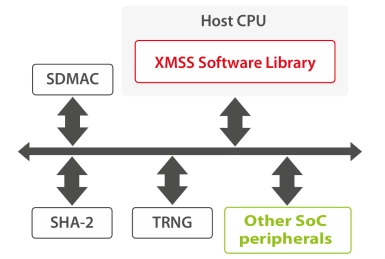
-
APB Post-Quantum Cryptography Accelerator IP Core
- Implements ML-KEM and ML-DSA post-quantum cryptography digital signature standards. The system interface is an microprocessor slave bus (APB, AHB, AXI options are available).
- The design is fully synchronous and requires only minimal CPU intervention due to internal microprogramming sequencer.
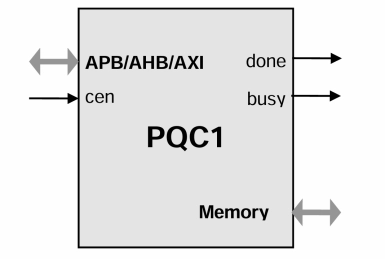
-
Crypto Coprocessor with integrated Post-Quantum Cryptography IPs
- The Crypto Coprocessors are a hardware IP core platform that accelerates cryptographic operations in System-on-Chip (SoC) environment on FPGA or ASIC.
- Symmetric operations are offloaded very efficiently as it has a built-in scatter/gather DMA. The coprocessors can be used to accelerate/offload IPsec, VPN, TLS/SSL, disk encryption, or any custom application requiring cryptography algorithms.
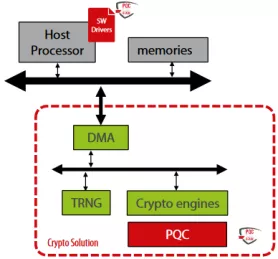
-
Unified Hardware IP for Post-Quantum Cryptography based on Kyber and Dilithium
- Turn-key implementations of the NIST FIPS recommended CRYSTALS post-quantum for key encapsulation (KEM) and digital signature algorithm (DSA)
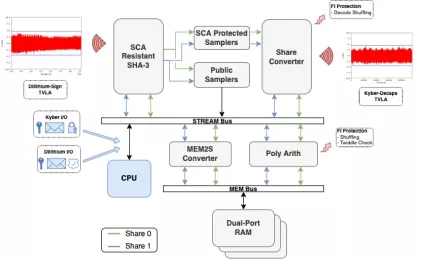
-
ML-KEM / ML-DSA Post-Quantum Cryptography IP
- ML-KEM (Crystals-Kyber) and ML-DSA (Crystals-Dilithium) are Post-Quantum Cryptographic (PQC) algorithms, meaning they are mathematically designed to be robust against a cryptanalytic attack using a quantum computer.
- Both have been standardized by the NIST in it post-quantum cryptography project.
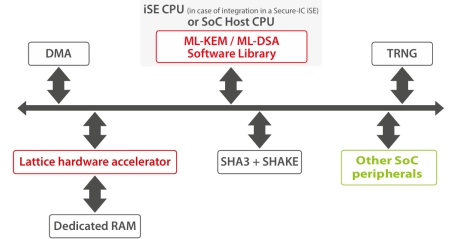
-
Post-Quantum Accelerator
- The Post-Quantum Cryptography IP core provides a high-efficiency hardware solution supporting ML-KEM (Kyber) and ML-DSA (Dilithium) as standardized in FIPS 203 and 204, along with additional hash-based signature schemes including SPHINCS+, XMSS, and LMS.
-
Post-Quantum ML-KEM IP Core
- Efficient Performance
- SCA/FIA Protections
- Patented High-Performance Modulo Multiplication
- Flexible Interfaces
-
Crypto Box Toolset Secure Accelerator
- The Hybrid Crypto Box IP core is a comprehensive, high-efficiency cryptographic solution that combines RSA, ECC, AES, and SHA-2/HMAC with a built-in accelerator for post-quantum algorithms such as ML-KEM (Kyber) and ML-DSA (Dilithium). Designed for embedded systems with balanced resource constraints, it enables secure key exchange, digital signatures, authenticated encryption, and hashing, future-proofed for the quantum era.